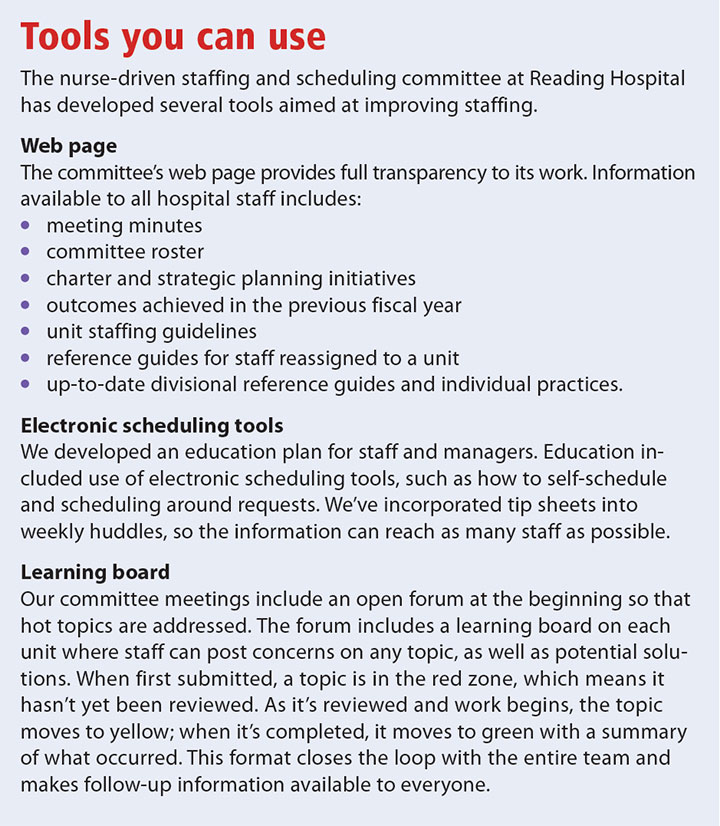With nurse input, this hospital strives for staffing satisfaction.
Takeaways:
- Staffing and scheduling presents some of the greatest challenges for both leaders and clinical staff.
- Collaborative efforts around staffing decisions enhance engagement.
- Input from direct line staff drive informed change.
By Ann Blankenhorn, MSN, MBA, RN, NEA-BC


As in many organizations, staffing and scheduling practices can be a source of staff satisfaction or dissatisfaction. In 2014, in an effort to ensure staffing satisfaction, nursing leadership formed a nurse-driven staffing and scheduling committee composed of 50% direct-care RNs. We began our journey focused on safe staffing practices, using the American Nurses Association’s principles for nurse staffing as our foundation.
The committee first worked to develop a solid charter that identified functions and responsibilities, including:
- developing, reviewing, evaluating, and implementing hospital-wide nurse staffing plans
- creating recommendations for unit-based staffing teams and identifying opportunities to optimize staffing resources
- providing education on topics such as benchmarks (including ActionOI® and the National Database of Nursing Quality Indicators®) and policy.
Building a solid team
The current committee is made up of 65% direct-care nurses and 35% hospital leadership and support staff, including patient care assistants, payroll and electronic staffing system members, representatives from the reassignment team and patient safety, and a member from human resources (HR). We meet once a month for 90 minutes.
The clinical staff provides insight into what’s happening in practice and how it’s managed throughout the nursing areas. Alignment with interprofessional committee members helps with problem solving and idea sharing. For example, the HR member provides a direct link to that department to identify and quickly address topics such as pay and compensation, as well as policy and practice. Receiving accurate information quickly helps the team better understand problems and solutions and provides transparency to the divisions and units. And with the help of the reassignment team member, we moved the reassignment survey to an electronic format, which lets participants respond anonymously, giving us more open feedback.
Achieving accomplishments
During the last 3 years, we’ve achieved many accomplishments, including aligning pay to hours, incorporating turnover and vacancy data, creating vacation and holiday time guidelines, standardizing call-off time requirements, and balancing schedules by divisions before posting.
We continue to work to ensure consistent and fair practices for all nursing staff. Currently, we’re exploring the following topics:
- incentives to pick up extra shifts
- best practices related to 12-hour shifts
- automated emails for the reassignment survey
- staffing effectiveness and safety issues.
For example, the organization offers financial incentives to encourage nurses to pick up an extra shift. However, the staffing and scheduling committee identified that not everyone is motivated by the same thing, so we conducted a brainstorming session to look at what motivates people. We learned that extra paid time off and the ability to reduce accrued attendance points were important to some staff.
Learning lessons
Nurse-driven staffing committees help encourage engagement around the most difficult topic nurse leaders face. Our committee has been very realistic and effective in making difficult decisions that incorporate the greater good of the organization and the patients. Turnover reports for the last 2 years identify the top four reasons for leaving: another job opportunity, family obligations, relocation, and retirement. The committee will continue to identify any connections between global scheduling issues and turnover.

Ann Blankenhorn is the senior nursing director at Reading Hospital in Reading, Pennsylvania.
ant3-Magnet Stories-221



















3 Comments.
I am a LPN that has been working as one for 3 years in a skilled nursing facility and I am trying to help my place of employment boost staff morale and help with staff burnout, improve staff appreciation, and maintain better word of mouth throughout the community. Within this year my place of employment has struggled with these few things and I am trying to make a stand for not only my other fellow co-workers as well as the residents getting taken care of under these circumstances! I am just not sure how to start my own committee to bring more light and life back into my place of work to make everyone happy and begin to spread the word in a positive light rather than negative!! Please help!!!
I am writing in response to Ann Blankenhorn’s article “Staffing committees: A safe staffing solution that includes engagement” published in Volume 13, Issue 3 of the March 2018 edition of American Nurse Today which followed staff at Reading Hospital. Blankenhorn spoke extensively about the challenges in finding suitable staffing practices and methods that can be used to improve both staff and patient satisfaction. Blankenhorn’s study covered a span of three years where different methods were used to build a solid team-based mentality throughout the hospital instead of just in the individual departments. As a recent RN graduate, this article has motivated me to investigate the methods employed at my current place of employment regarding safe staffing solutions. It has also encouraged me to discuss these methods and how they are currently working with my unit manager. These methods include cross-training nurses from other departments, calling in on-call nurses once census hits five patients per nurse, and having an open-door policy to discuss any concerns that may arise. There is also a suggestion box for any employees who do not feel comfortable discussing their concerns in person.
I was disappointed that Blankenhorn failed to mention any of the possible negative effects caused by short staffing. Stephanie Jones-Berry’s article “Poor working conditions drive nurses to the brink” published in Volume 33, Issue 3 of the June 2018 of Nursing Standard discusses a survey of 2000 nurses and negative effects of understaffing. Nurses surveyed admitted having thoughts of self-harm or suicide, undergoing treatment for depression, use of alcohol or drugs to cope, as well as having to receive care for kidney stones due to not being able to find time to take a break for food, water, or to use the bathroom. I feel that a study should have been included where the staff at Reading Hospital were anonymously polled about these potential effects, steps taken to rectify these issues, and if the changes mentioned in the article had a positive or negative long-term outcome.
Understaffing is a nationwide problem. Not only can it have a negative impact on staff but the patients as well. It is important for management to address these issues to help maintain patient safety and decrease errors. Jones-Berry pointed out that it is the employer’s responsibility to look after the basic needs of their personnel to help prevent these complications. It is important for management to not only be aware of the negative aspects of short staffing, but also how to recognize signs in their employees. Policies and structures should be in place to provide this assistance. Even if it’s something as simple as giving them a chance to discuss their concerns in a judgement free environment. Jones-Berry advocated for encouraging employees to seek support at the earliest occasion to maintain a safe working environment for all.
Thank you for your time to read my response,
Solmarie McMann RN, RN-BSN-Student
Including bedside staff into multiple decision making processes is a great first step for hospitals. Bedside staff are the ones on the front lines of care and ultimately the ones on the receiving end of decisions being made. Our company lets our mobile app for scheduling spread for free to highlight gaps in what hospitals are providing that can be fixed with technology. It’s just another avenue for staff members to indicate their preferred technology and assert their influence, sometimes when they have none.